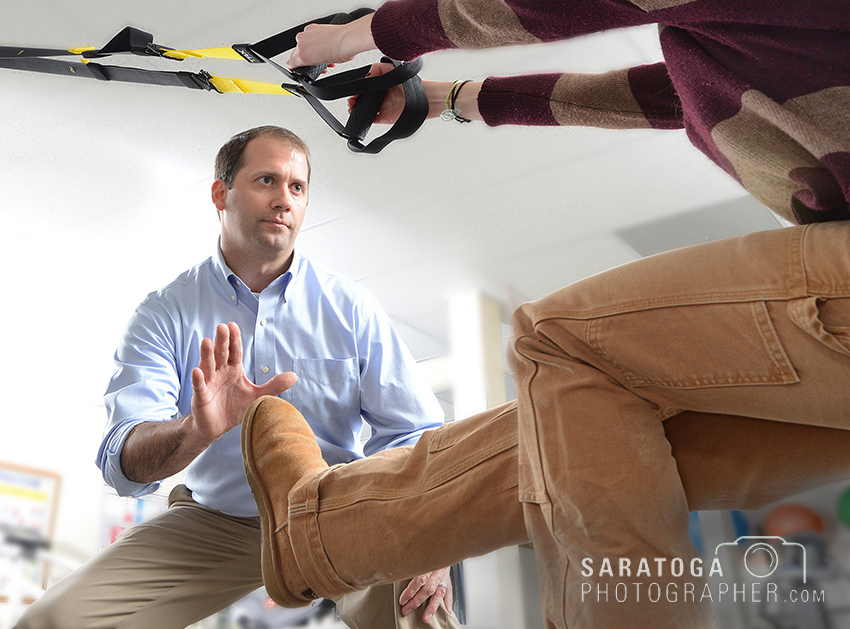
©2017 Saratoga Photographer.com
By Jill Nagy
“Sitting is the new smoking,” said Alison Synakowski, manager of the Malta and Saratoga Springs offices of Sports Physical Therapy in Motion.
She and several colleagues find that many of the work-related problems that send people to a physical therapist are the result of too much sitting and improper sitting.
Synakowski advocated “active sitting,” putting things you frequently use in places where you have to reach for them. She also urged people to get up and walk around at least once an hour, a prescription that is also favored by other area physical therapists.
“Our bodies are not built for sitting. They are built for standing and moving around,” said James Markwica, owner of La Marco Physical Therapy PC in Saratoga Springs.
He estimated that between one-fifth and one-quarter of his practice involves lower back, neck and other pains resulting from poor and/or excessive sitting. He helps clients work on their posture and strengthen their core muscles.
When people sit, he suggests an adjustable chair and following the “rule of 90s.” That means: feet flat on the floor; ankles, knees and hips at 90-degree angles; arms hanging at the sides with the elbows at 90-degree angles; and hands in front. The head should rest squarely on top of the shoulders.
A “standing desk” is also widely advised.
“It’s basically how I spend my entire day,” said Matthew O’Neil, who heads the Malta office of Saratoga Physical Therapy.
He said he has his office set up with an elevated work station so that he can do his paperwork standing up. Since he is on his feet all day, O’Neil said, he is also careful to wear supportive shoes. His preference is for clogs. He also had his secretary’s keyboard lowered to ease the strain on her shoulder after surgery.
Sedentary jobs with minimal movement lead to strain on certain muscles, O’Neil pointed out. Proper positioning of equipment is critical and he tries to get a good overview of what a patient’s work station looks like.
In the past, problems also arose from the practice of shouldering a telephone receiver—placing it between shoulder and ear in order to keep hands free for tying or other use—but the wider use of phone headsets has obviated that problem. He also finds that people are more aware of the effect of their posture at work, so he sees fewer people with bad posture.
Synakowski said she often begins a series of treatments with an ergonomic assessment. She discusses the set up of the patient’s work station and makes suggestions to improve it. She often suggests a stand-up desk or a better chair, at times providing a letter of medical necessity to a patient’s employer.
People with more active and physically demanding jobs may also develop neck or back pain. However, Synakowski noted, the causes may be different. In those cases, she may work on improving lifting techniques and improving strength and mobility.
“Everyone knows not to bend forward to lift, but we teach them why,” she said. She stresses that proper lifting technique protects the discs in the spine.
“Sometimes the education piece is the most important,” she noted.
Markwica sees back pain and foot and ankle problems in patients with active jobs. He emphasized the need for proper footwear and the importance of replacing it at least once a year. He also urges people to frequently sit down, the opposite of the advice he gives to sedentary workers.
For people who sit a lot, he is a believer in proper chairs. He refers patients to vendors who offer good stable chairs with a high durability rating, a measure of the number of hours one can comfortably sit in them. Also, the more adjustable, the better, he added. Such chairs do not come cheap, he said, generally costing more than $100, in some cases, $1,000 or more.
The sorts of pains that runners complain of “may also be the result of what you’re doing when you sit,” Synakowski said. What a person does most during the day also affects everything else, she noted.
The therapists also noted that a change in New York state law now allows people to see a physical therapist without a referral from a physician. Generally, treatment is covered by medical insurance.
Saratoga Physical Therapy has an office at 5 Care Lane, managed by Anthony DeMatteo. The telephone number is 587-5670. O’Neil is in charge of the Malta office at 2388 Route 9, across from Global Foundries. That telephone number is 899-1140.
Synakowski’s offices are part of a Sports PT Care in Motion facilities group with offices in locations from Buffalo to Saratoga Springs. She operates offices at 1 West Ave. in Saratoga Springs and 4102 Ellsworth Boulevard in Malta. The telephone number is 583-7537.
LaMarco Physical Therapy has two offices, both owned and managed by Markwica, at 538 Maple Ave. in Saratoga Springs and at 417 Geyser Road in Ballston Spa. The telephone number is 587-3256.
